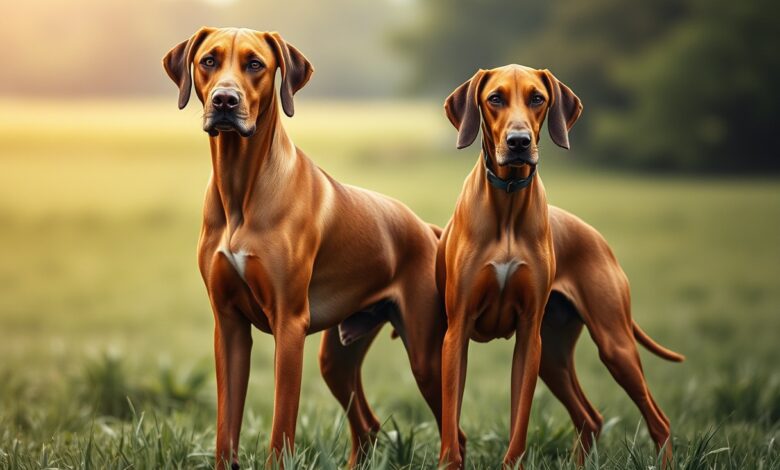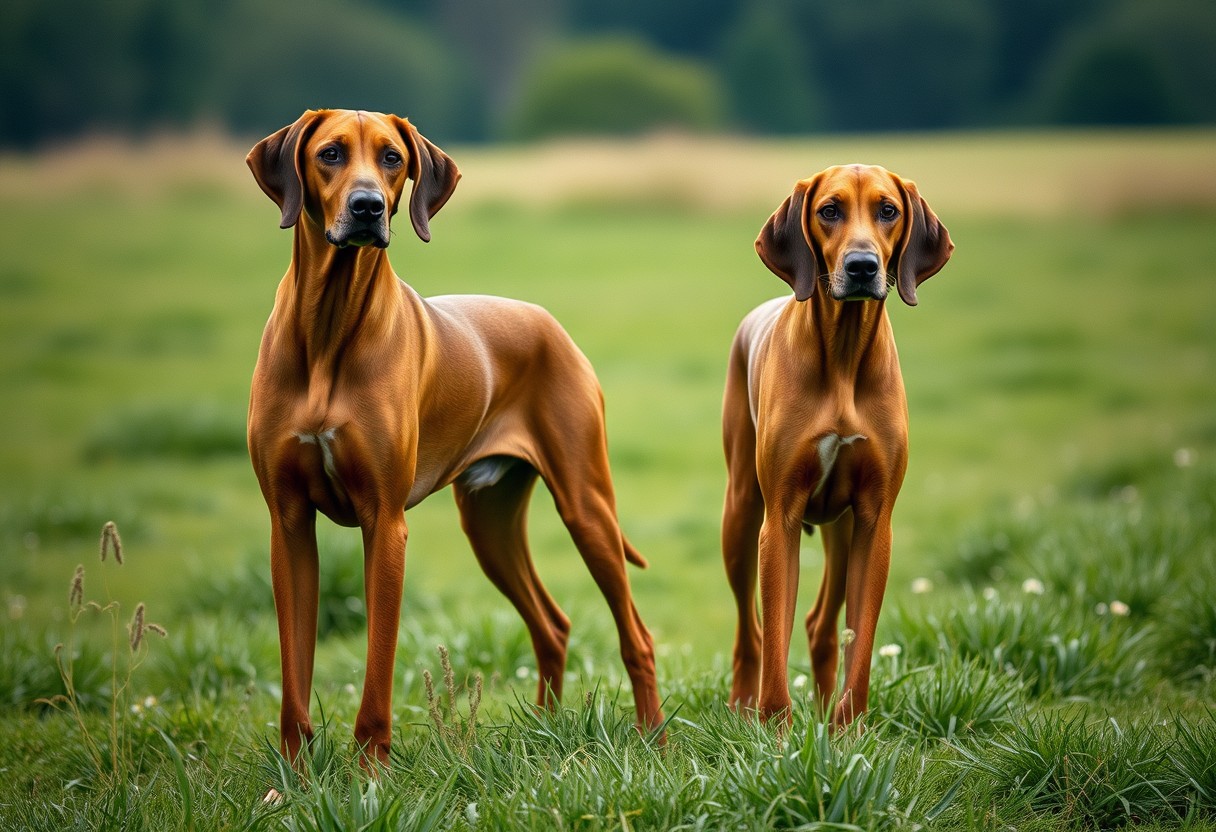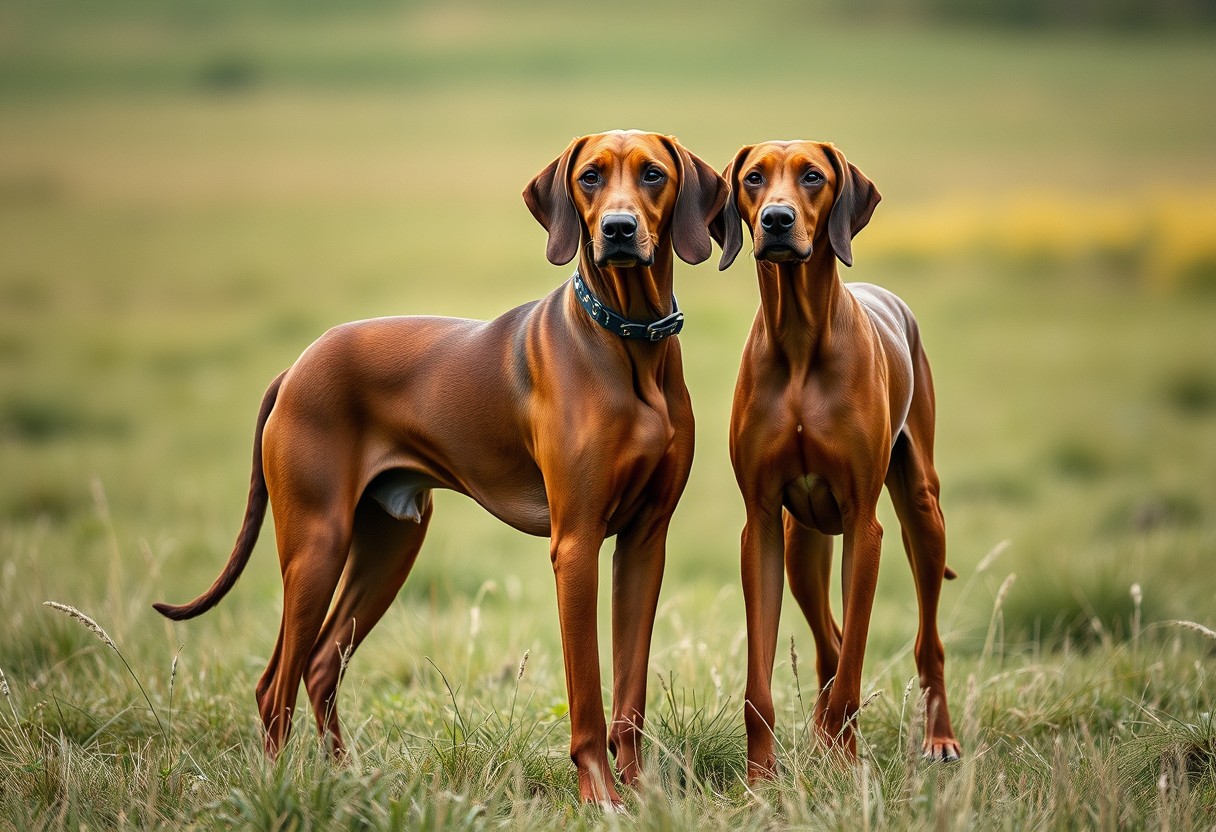Rhodesian Ridgeback vs Redbone Coonhound – 12 Crucial Differences

Many dog enthusiasts often find themselves torn between two remarkable breeds: the Rhodesian Ridgeback and the Redbone Coonhound. Both breeds offer distinct qualities that cater to different lifestyles and preferences. Understanding the 12 key differences between these breeds can significantly impact your choice if you’re looking to adopt or simply want to improve your knowledge. From their unique temperaments to their exercise needs, this guide will equip you with imperative insights to make an informed decision that best suits your life and home environment.
Key Takeaways:
- Breading Background: The Rhodesian Ridgeback was originally bred in Southern Africa primarily for hunting lions, while the Redbone Coonhound is developed in the United States for tracking and hunting raccoons.
- Physical Appearance: Rhodesian Ridgebacks possess a distinctive ridge of fur along their back, whereas Redbone Coonhounds have a sleek, red coat and long, floppy ears.
- Temperament: Ridgebacks are known for their loyalty and protectiveness, making them great family dogs, while Redbone Coonhounds are more energetic and tend to have a friendly, outgoing personality.

History and Origin
To understand the Rhodesian Ridgeback and Redbone Coonhound, you must research into their unique origins, which shaped their physical traits and temperaments. The Rhodesian Ridgeback’s development in Africa and the Redbone Coonhound’s emergence in the United States both highlight the distinct purposes these breeds were designed for, influencing their appearance and behavior in significant ways.
Rhodesian Ridgeback Origins
Above all, the Rhodesian Ridgeback originated in southern Africa, developed by indigenous Khoikhoi people and European settlers. This breed was renowned for its exceptional hunting abilities, particularly for tracking and hunting lions, as well as guarding homesteads. Its unique ridge of hair along the spine is a distinctive feature that emerged from adapting to the African environment, signaling both its resilience and strength.
Redbone Coonhound Origins
Origins of the Redbone Coonhound trace back to the United States, where early settlers blended various hound breeds for superior hunting capabilities. Designed specifically for tracking and hunting, this breed excels at tracking raccoons and other game, thanks to its keen sense of smell and endurance. The Redbone Coonhound became a valued companion for hunters, demonstrating versatility in different terrains.
Plus, the Redbone Coonhound’s history is marked by its incredible ability to adapt and meet the rigorous demands of hunting in the American wilderness. With a strong instinct for tracking, this breed has been instrumental in hunting both small and large game, showcasing its intelligence and fearlessness. Additionally, the Redbone Coonhound’s friendly disposition and loyal nature make it an excellent companion for families, balancing its hardworking traits with a gentle temperament.
Physical Characteristics
One of the most noticeable differences between the Rhodesian Ridgeback and the Redbone Coonhound lies in their physical characteristics. While both breeds are strong and agile, they have distinctive traits that influence their appearance and performance. The Ridgeback is recognized for its unique ridge of hair along its back, which sets it apart from the sleek, smooth coat of the Redbone. These features not only contribute to their individual beauty, but also affect their adaptability to various roles, including hunting and companionship.
Size and Build
An necessary distinction between these two breeds is their size and muscular build. The Rhodesian Ridgeback typically stands between 24 to 27 inches tall and weighs between 70 to 85 pounds, exhibiting a robust and muscular frame. In contrast, the Redbone Coonhound ranges from 21 to 27 inches in height and weighs approximately 45 to 70 pounds, presenting a leaner physique. This difference in size affects their agility and suitability for different roles, with the Ridgeback being more suited to heavier tasks while the Redbone excels in agility and speed during hunts.
Coat and Color
Across the two breeds, you will notice that their coat types and color variations play an important role in grooming needs and overall maintenance. The Rhodesian Ridgeback has a short, dense coat that is easy to maintain and comes in a range of wheaten shades, while the Redbone Coonhound features a smooth, short coat generally in a reddish hue, requiring similar, although slightly more frequent grooming due to shedding during certain seasons.
The RFodesian Ridgeback features a short, dense coat that is easy to maintain, while grooming is minimal, and shedding is manageable, making it a great option for busy owners. On the other hand, the Redbone Coonhound’s smooth coat is predominantly reddish, and although it requires regular brushing, their shedding seasons may demand extra attention. Both breeds share a strong build, but your grooming regimen could vary based on your choice between these two beautiful dogs.
Temperament and Behavior
Your understanding of the temperament and behavior of the Rhodesian Ridgeback and Redbone Coonhound is imperative for making an informed decision about which breed suits your lifestyle. These dogs exhibit distinct traits that can impact their compatibility with your home. The Ridgeback is known for its strong loyalty and protective instincts, making them great companions and guardians. In contrast, the Coonhound possesses a friendly, social disposition, thriving on interaction with both humans and other pets. These differences in sociability and energy levels are crucial when considering your family’s dynamics.
General Temperament
The Rhodesian Ridgeback typically displays an independent and often aloof demeanor, requiring patient socialization and consistent training. They are energetic and enjoy outdoor activities, making them a great match for active families. On the other hand, the Redbone Coonhound is known for its friendly and affectionate nature, thriving on companionship and interaction. This sociable breed often excels in multi-pet households, fostering strong bonds with other animals. Understanding their individual temperaments will guide your decisions on how best to integrate these breeds into your life.
Training and Intelligence
General assessment of both breeds reveals that the Rhodesian Ridgeback is intelligent but can be quite stubborn, making them moderately challenging to train. To facilitate effective training, utilize positive reinforcement techniques and keep sessions engaging. The Redbone Coonhound is also intelligent but may be distracted by scents and sounds, so incorporating scent-based games can enhance their focus. Both breeds benefit immensely from early socialization to help them develop well-rounded behaviors and manners.
Also, you should be aware that although both breeds can be trained, they have different approaches to learning. The Ridgeback often needs a firm and consistent handler due to their independent streak, while the Coonhound requires patience to manage their occasional distractibility. Establish a strong foundation of trust and respect through positive reinforcement, as this will encourage desired behaviors in both breeds. Socialization should not be overlooked, as it is imperative in building a well-adjusted pet who is comfortable in various situations.
Exercise and Activity Needs
All dogs thrive on proper exercise and activity to maintain their health and happiness. The Rhodesian Ridgeback and Redbone Coonhound have distinct exercise requirements due to their energy levels and backgrounds. Ridgebacks, bred for hunting lions, require vigorous activities such as running and hiking to expend their high energy. Meanwhile, Redbones, originally hunter dogs, enjoy energetic pursuits like chasing scents and participating in games. Both breeds need regular exercise to keep them physically fit and prevent behavioral issues related to insufficient activity.
Activity Levels
At a glance, the Rhodesian Ridgeback demands at least 60 to 90 minutes of exercise daily, enjoying long runs and engaging trails that allow them to stretch their legs. Alternatively, the Redbone Coonhound requires approximately 60 minutes of daily exercise, thriving in activities that stimulate their keen sense of smell, like scent tracking and hunting games. Both breeds benefit from outdoor adventures that challenge them physically and engage their instincts.
Mental Stimulation
The mental well-being of both dogs is equally important as their physical activity. The Rhodesian Ridgeback is intelligent and needs mental challenges to avoid boredom, while the Redbone Coonhound, being equally smart, benefits from stimulating tasks and games. Incorporating interactive games such as fetch, puzzle toys, and obedience training into your routine helps keep their minds sharp and satisfied.
Hence, providing sufficient mental stimulation is important for both the Rhodesian Ridgeback and Redbone Coonhound. Engaging your dog in interactive games and training exercises not only fulfills their intellectual needs but also strengthens the bond between you and your pet. Activities such as hide-and-seek, advanced obedience training, or even agility courses can keep their minds active, reducing behaviors stemming from boredom, such as destructive chewing or barking. A mentally stimulated dog is a happy and well-adjusted companion, making these activities vital parts of your shared routine.

Health Considerations
For anyone considering adding a Rhodesian Ridgeback or a Redbone Coonhound to their family, being aware of their health considerations is vital. Both breeds have their unique health profiles and may be predisposed to certain conditions. Regular vet check-ups and a solid preventative care routine will help ensure your dog maintains optimal health throughout their life.
Common Health Issues
Between the two breeds, the Rhodesian Ridgeback is prone to conditions like hip dysplasia, skin issues, and certain cancers, while the Redbone Coonhound may face hip dysplasia, ear infections, and certain genetic disorders. It’s vital to research lineage and ask breeders about hereditary health issues. Regular vet visits for check-ups and vaccinations, along with a balanced diet and proper exercise, will keep your furry friend healthy.
Lifespan and Care
Among the two breeds, the Rhodesian Ridgeback generally has a lifespan of about 10-12 years, while the Redbone Coonhound typically lives around 10-12 years as well. To ensure your dog’s health and longevity, provide them with a balanced diet, consistent exercise, and mental stimulation. Regular preventative care, such as vaccinations, dental care, and routine screenings, is vital. These practices not only enhance your dog’s quality of life but also strengthen the bond you share.
It is important to consult with your vet about dietary needs, exercise routines, and any breed-specific precautions. Providing your dog with a stimulating environment and *regularly scheduled check-ups* can prevent some issues from arising. By being proactive about your dog’s health, you can enjoy many happy years together, potentially surpassing their expected lifespan and creating *memorable experiences*. Overall, attentive care and informed decisions are the keys to a long and fulfilling life for your Rhodesian Ridgeback or Redbone Coonhound.

Living Conditions
Keep in mind that both the Rhodesian Ridgeback and the Redbone Coonhound have specific living condition requirements that can greatly affect their well-being and happiness.
Suitable Environments
Before choosing a breed, consider the Rhodesian Ridgeback, which thrives in large homes or yards with plenty of space to roam and is adaptable to both warm and moderate climates. In contrast, the Redbone Coonhound is also best suited for homes with space, but it can adapt slightly better to different living situations, including larger apartments, as long as they receive ample exercise and mental stimulation.
Family Compatibility
Between the two breeds, the Rhodesian Ridgeback is known for being loyal and protective, making it a great companion for families with older children. Meanwhile, the Redbone Coonhound tends to be friendly and sociable, but their strong prey drive may pose challenges with smaller pets or children. Both breeds require proper socialization to ensure they fit well into your family dynamic.
In addition, while the Rhodesian Ridgeback’s strong guarding instincts can contribute to your family’s safety, it also means they might be more reserved around strangers. The Redbone Coonhound, on the other hand, is often more relaxed and outgoing, making them ideal for families who entertain guests. However, their curiosity and instinctual hunting behavior can make them less reliable around smaller animals, so you should keep a close eye on their interactions to maintain harmony in your household.
Final Words
The differences between the Rhodesian Ridgeback and the Redbone Coonhound can significantly impact your decision as a pet owner. Each breed has unique traits, from energy levels to care needs, that align with different lifestyles. By understanding these distinctions, you can choose a companion that fits seamlessly into your life. If you want to learn more about the Redbone Coonhound, including its characteristics and care, check out Redbone Coonhound: Characteristics & Care.
Q: What are the primary differences in temperament between Rhodesian Ridgebacks and Redbone Coonhounds?
A: Rhodesian Ridgebacks are known for their loyalty, independence, and confidence. They were originally bred for hunting big game in Africa, which gives them a strong and assertive personality. In contrast, Redbone Coonhounds are typically more sociable and friendly, making them great family pets. They have a relaxed demeanor and are eager to please, which reflects their background as versatile hunting dogs used for tracking and treeing game. Therefore, while Rhodesian Ridgebacks may exhibit a more protective and less submissive nature, Redbone Coonhounds tend to be easier to train due to their desire to bond with humans.
Q: How do the exercise needs of Rhodesian Ridgebacks compare to those of Redbone Coonhounds?
A: Both breeds require a considerable amount of exercise, but their intensity and preferences may vary. Rhodesian Ridgebacks, being larger and more muscular, benefit from vigorous activities such as running and agility training to maintain their strength and mental stimulation. They thrive with at least an hour of exercise each day. On the other hand, Redbone Coonhounds are equally active but they typically enjoy more variety in their activities, such as hiking and scent tracking. They also need about an hour of exercise daily, focusing more on exploration and less on high-energy bursts. Thus, while both breeds are active, their exercise preferences and requirements differ slightly.
Q: What are the differences in grooming needs for Rhodesian Ridgebacks and Redbone Coonhounds?
A: The grooming needs of these two breeds also differ significantly. Rhodesian Ridgebacks have a short, dense coat that sheds moderately and requires minimal grooming. Regular brushing once or twice a week is generally sufficient to keep their coat healthy and remove loose hairs. Conversely, Redbone Coonhounds have a short coat that may require more frequent brushing, especially during shedding seasons, as they tend to shed quite a bit. Additionally, Redbones may require regular ear cleaning due to their longer ear structure, which can trap dirt and moisture. Therefore, Rhodesian Ridgebacks are lower maintenance in terms of grooming while Redbone Coonhounds need a bit more attention to their coat and ears.





